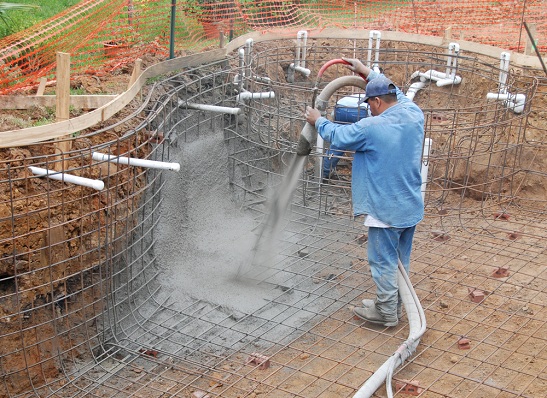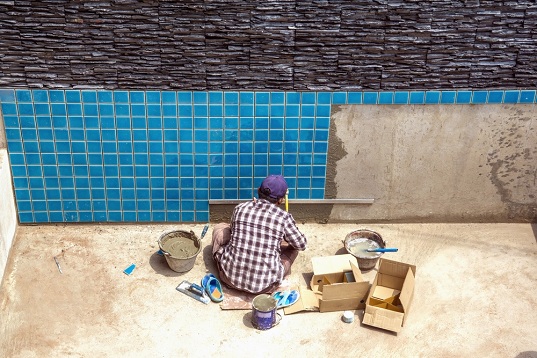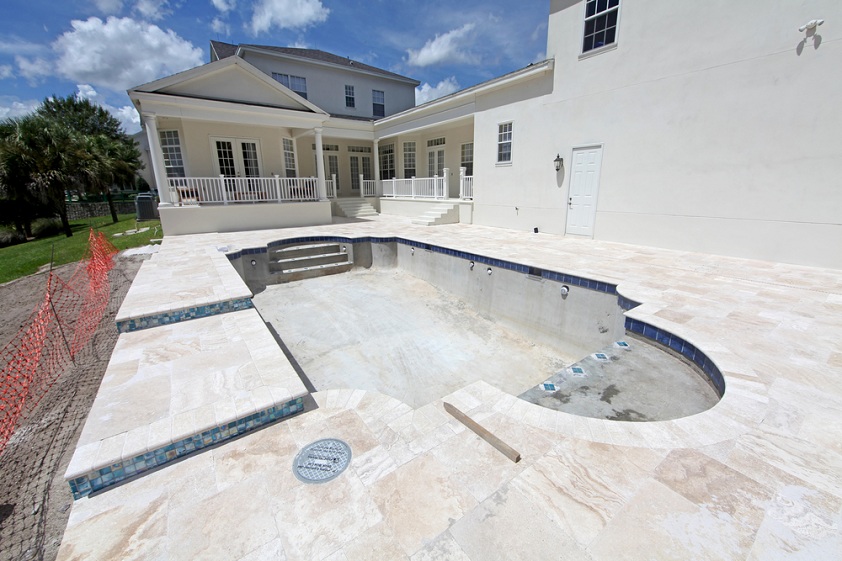What Is a Gunite Pool?
A gunite pool is an in-ground swimming pool constructed using a special type of concrete called “gunite” to build the flooring and walls of the pool and sometimes the decking surrounding the pool.
Gunite pools come in many shapes and usually range from 10 feet wide to 50 feet wide.
Some gunite pools are simple rectangles or ovals.
However, gunite is often the material choice for most custom-designed pools due to concrete’s ability to be set into almost any shape imaginable.
Benefits of Gunite Pools
1. Gunite pools are more durable than fiberglass and above-ground pools.
Gunite pools are very durable, typically lasting for decades. This means that you can enjoy your pool for a long period without worrying about maintenance costs.
Most fiberglass and vinyl inground pools need their liners changed every few years and are more prone to leak than gunite pools.
In contrast, gunite pools have been known to last for 50 years with little more than a good professional cleaning every 5-10 years.
2. Gunite pools can be built in almost any conceivable shape.
Because liquid concrete forms the foundation, almost any design can be brought into reality. Almost all complex custom pools are built from gunite for this reason.
3. Gunite pools cost less to heat (per gallon) than other types of pools.
Because they are built from two layers of concrete and completely enclosed by earth, gunite pools are extremely well insulated compared to many other types of pools.
4. Gunite pools can be easier to maintain.
Concrete is extremely resistant to stains and surface issues. You don’t need special equipment or chemicals to keep it clean.
5. Gunite pools rarely, if ever, spring a leak.
These pools are tough. It’s rare for a gunite pool to leak through its side.
In addition, you don’t need to worry about puncturing a liner or accidentally breaking a water line with most gunite pools, two things you will need to watch with above-ground and vinyl-lined pools.
Drawbacks of Gunite Pools

1. Gunite pools are more challenging to install
It takes significantly longer to install a gunite pool than an above-ground or fiberglass pool.
Special concrete and structural engineering skills are often required, and heavy equipment is needed.
2. Gunite pools are harder to repair than conventional pools.
If you ever spring a leak, fixing the problem will cost a lot. This is because the pool will need to be drained and earth excavated to repair the failed concrete.
3. Gunite pools are more expensive than other types of pools.
On a per-gallon basis, gunite pools often cost 50% more than fiberglass and vinyl pools.
However, it is worth the investment if you plan to keep your pool for many years.
How Much Does A Gunite Pool Cost?

The average cost of a gunite pool ranges from $20,000 to $100,000, depending on the pool size, design complexity, decorative features, water features, and heating/cooling systems you want.
The price of a gunite pool depends mainly on the size of the project.
Smaller projects like a 12,000-gallon 16′ x 24′ rectangular wading pool will start at around $20,000, while a custom-designed 50,000-gallon gunite pool with a waterfall, jacuzzi tub, custom tilework, a heater, and a large paver deck surrounding it can exceed $100,000.
Installing a Gunite Pool

The process for installing a gunite pool is similar to that of any other inground project, except for the concrete work.
These are the basic steps:
1. Survey Your Property
Before you begin any construction project, you must survey the area where you intend to install the pool.
During this survey, your pool professional will determine where your sprinkler lines are, how deep your water table is, what sort of earth will need to be removed, whether the underlying soil can serve as a foundation and other critical engineering factors.
2. Design the Pool
Once you’ve measured your property, you’ll need to determine how big the pool should be and what shape/design it will take.
Typically, your pool professional will offer to prepare drawings based on your input. It will likely take several attempts to agree on the final design.
Common standard sizes include: Olympic-sized (50×25 feet) and standard-sized (30×20).
When deciding on the size of your pool, it is important not to overbuild. All your downstream ownership costs – heating, cleaning, maintenance, pool pump/filter, et al – will be driven mostly by the gallons of water in your pool.
So make sure you buy the smallest pool that will meet your needs 90% of the time.
3. Select materials, trim, decking, and other features
Near the end of your design process, you will need to decide on the features and options for your pool.
There are many choices to make at this point, including:
- Do you want to add a spa or jacuzzi?
- Do you want a waterfall or another water feature?
- Underwater lighting: will one spotlight suffice, or do you want something more decorative?
- Steps or ladder?
- Decorative trim: do you want cobalt blue tiles along the inner lip and edges of your stairs, et al? do you want an all-tile pool surface ($$)? is there a mural in your mind?
- Decking: do you want a standard concrete deck or something more decorative like pavers?
- Heating and cooling: do you live in a colder climate or an especially warm area? do you want solar heating or gas?
- and more
Once your final design is complete, you may need to submit it to your homeowner’s association and/or local authorities for approval.
4. Excavation
The next step is to excavate your backyard to make room for your pool.
This will require heavy equipment to remove earth, tree roots, and rocks.
Often during excavation, new issues must be addressed, such as removing large boulders and soft zones found underground to make room for the pool and/or to shore up the foundation.
In addition, your sprinkler system and water lines may have to be moved to another location.
After the excavation, the pool team will dig trenches and install the water return and feed lines that move water to/from the pool pump/filter to the pool.
5. Fabricate the Gunite Shell
Before pouring the gunite, you’ll need to lay down a layer of sand to form a solid foundation for the concrete structure. Often, granite composite is added before the sand.
Then, a steel rebar system is built on top of the sand to provide a construction frame for your pool. These steel bars will reinforce the concrete once it sets.
6. Install Plumbing & Electrical
The plumbing & power lines are then run through the rebar frame, and end attachments are made for strainers, water jets, pool lighting, water features, and return lines.
7. Pour The Gunite
After the plumbing and rebar is installed, it’s time to add a layer of concrete to the pool floor.
To create the sides, steps, and special design features, your pool installer will likely attach wooden molds to the rebar frame to pour concrete into, then remove them after they harden.
Other key features will be molded/crafted during this process including steps, pool lighting, spas, and more.
After the steel-reinforced sections & features are fabricated, your installation team will come in and finish off the structure with another layer or two of gunite to even out and smooth the surface.
8. Add Coping and Decoration
As the final gunite layer is applied, the team will add decorative tiles and attach coping to the structure to complete the fabrication process.
Finally, the decking will be added after the structure dries and hardens.
9. Install and Test Pool Equipment
The final step is to attach your pool pump, filter, and cooling/heating systems to your water lines.
10. Fill and Enjoy Your New Pool
Now comes the fun part!
Once the gunite has hardened, you’ll need to fill the pool with water.
Filling a 30,000-gallon pool can take many hours to a day or more. And your water bill will be steep.
After it fills, you’ll need to add chlorine or salt to it to get the water chemistry right before using it.
FAQs
Q: What Size Does My Pool Need To Be?
A: It depends on how many people you plan to invite to swim in the pool. If you plan to host parties, you’ll need a larger pool.
Q: Can I Use PVC Pipe Instead Of Steel Bars?
A: No. PVC piping is installed to carry water to/from your pool and to contain power lines. Rebar is to reinforce your concrete structure.
Q: Why Is Gunite Better Than Fiberglass?
A: Gunite lasts longer, does not leak as much, and withstands damage much better than a fiberglass pool. In addition, you can build any shape imaginable with gunite, whereas fiberglass pools tend to be used for less elaborate designs.
Q: What Kind Of Pool Pump Do I Need?
A: Your pool pump needs to be sized to the number of gallons of water in your pool. We recommend variable-speed pumps, which are more efficient and longer-lasting than older single- or dual-speed pumps.
Q: How Long Will It Take To Construct My Pool?
A: Depending on the size of the pool and the materials used, construction can take anywhere from 1 to several weeks.

